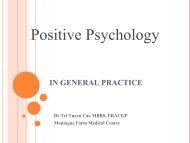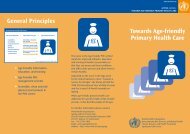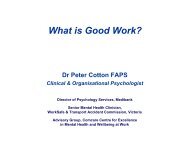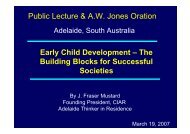Age-friendly Primary Health Care Centres Toolkit - World Health ...
Age-friendly Primary Health Care Centres Toolkit - World Health ...
Age-friendly Primary Health Care Centres Toolkit - World Health ...
- No tags were found...
Create successful ePaper yourself
Turn your PDF publications into a flip-book with our unique Google optimized e-Paper software.
AGE-FRIENDLY PRIMARY HEALTH CARE CENTRES TOOLKITIII.1 Organizing services for an age-<strong>friendly</strong> PHC centreThis section is primarily applicable to the health centre manager and local policy-makers.What are the key managerial elements for the success of an age-<strong>friendly</strong> PHCcentre?The effective implementation of an age-<strong>friendly</strong> PHC centre system will require politicalcommitment at the national and local levels, including adequate funding to meet theneeds of the older population and adequate number of trained staff.System reorientation of health systems towards continuing comprehensive care and anemphasis on a primary rather than a tertiary approach to care of older persons is needed.Below, there is a checklist of common operational and managerial barriers that mayimpact the effective implementation of the <strong>Age</strong>-<strong>friendly</strong> Principles in a PHC centre.Please make an action plan to address any barriers that are relevant to your PHC centreand include all stakeholders. Remember, the entire set of <strong>Age</strong>-<strong>friendly</strong> Principles doesnot need to be implemented at once – choose the principles you can implement andwork from there.Operational and managerial barriers1. Insufficient operationalization of <strong>Age</strong>-<strong>friendly</strong> Principles. Are there measurements orindicators that provide evidence of implementation of the <strong>Age</strong>-<strong>friendly</strong> Principles?2. Lack of, or incomplete information on health needed by the older population. Doesthe information system include appropriate health indicators for planning andevaluating the health needs of the older population?3. Absence of explicit responsibility for older people's health services negotiated withthe health system as part of the centre's management agreement. Does themanagement agreement include a budget for specific services to be provided forolder adults?4. Lack of clinical guides and protocols in geriatric preventive medicine including theprotocol for the periodic health exam of older adults. Is a periodic health exam withrequired lab and screening tests guaranteed to older adults?5. Lack of clinical guidelines, protocols and instrument to detect and address the healthneeds of older adults. Are clinical guides and protocols developed with the guidanceof professionals trained in geriatric care?6. Excessive focus on vertical problems based on disease rather than on an integratedapproach to improve the health in older age. Is quality of care estimated bymeasuring disease, or health and function?7. Lack of sustainable finance mechanisms to address the basic needs for essentialmedicine and nutrition of poor and extreme poor older adults. Are older adults thatare unable to purchase their medication or buy a balance meal able to receiveappropriate and timely assistance? How is their situation measured in comparisonwith the situation of other population groups?79
















